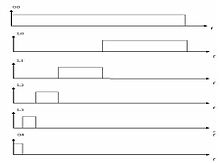Gauss-Laplace pyramid
The Gaussian or Laplace pyramids , also called Burt-Adelson pyramids or Gaussian and Laplace pyramids , are algorithms for digital signal processing . They were introduced into digital image processing in 1981/83 by Peter J. Burt and Edward H. Adelson in order to systematically standardize some known algorithms. 1988, the basic idea of this data structure was Stéphane Mallat and Yves Meyer in the functional analysis transmitted. There it is known as the multiscale analysis (MRA) of the wavelet theory .
The characteristics of digital images that are used to recognize certain structures or manipulate images include blurring and sharpness . Information on these characteristics can be found in the frequency bands . In order to determine the individual frequency bands, filter kernels or the Fourier transformation can be used, which is associated with considerable computational effort. Alternatively, a Gauss-Laplace pyramid can be used.
Creation of a Gauss-Laplace pyramid
In order to develop a Gauss-Laplace pyramid, a Gaussian pyramid must first be constructed. The original image represents the lowest pyramid level G0 . The next higher level G1 is calculated using a low-pass convolution ( ) and halving the support points of G0 . This process continues from stage to stage until the image reaches a size of 1 × 1 pixel . The low-pass folding is implemented using a folding with a Gaussian bell . In practice, the image is convoluted with a binomial filter. It should be noted that the original image G0 must have a side length of pixels (an image can be divided into image blocks). The resulting Gaussian pyramid from the images of the various levels corresponds to a division into images, each of which represents a certain frequency component. Each successor of an image only has a quarter of the pixels of the previous one.
After a Gaussian pyramid has been constructed, a Laplace pyramid is developed from it. A Laplace pyramid level is achieved by forming the difference between two neighboring Gaussian pyramid levels. This is known as the DoG ( difference of Gaussian ) algorithm . Both stages must be the same size. Since this is not the case with the Gaussian pyramid, the smaller image must be brought to the size of the other image by interpolation . The individual Laplace pyramid levels represent the sharpness of an image. The image L0 contains the highest frequency components.
After the Gauss-Laplace pyramid level has been formed and the individual layers may have been processed, the Gauss-Laplace pyramid must be reconstructed. To do this, the desired Laplace pyramid levels and the highest Gaussian pyramid level are added up.
application
The Gauss-Laplace pyramid is used to solve numerous image processing processes. A popular area of application is data compression . During the data compression of an image, high frequencies are removed, as these represent the least amount of information. For this purpose, the highest Laplace pyramid levels are omitted. In addition, the support points can be quantized and the individual levels can be represented using a quadtree . One advantage of this method is the intelligent decompression: The lower levels of the image pyramid are decompressed first, because the lower frequencies contain the most information and require the least amount of computation. The image is built up during decompression.
Another possible application is mosaicing . Different images are merged with one another by dividing the images into image pyramids and weighting and adding them up using a mask. The image is then reconstructed and possibly post-processed. The frequency bands are edited separately in order to avoid edge formation.
Gauss-Laplace pyramids are also used in surface and structure recognition. Here you make use of the sharpness and blurring of images. With this method, certain frequency bands of an image are determined in order to then process this information further.




